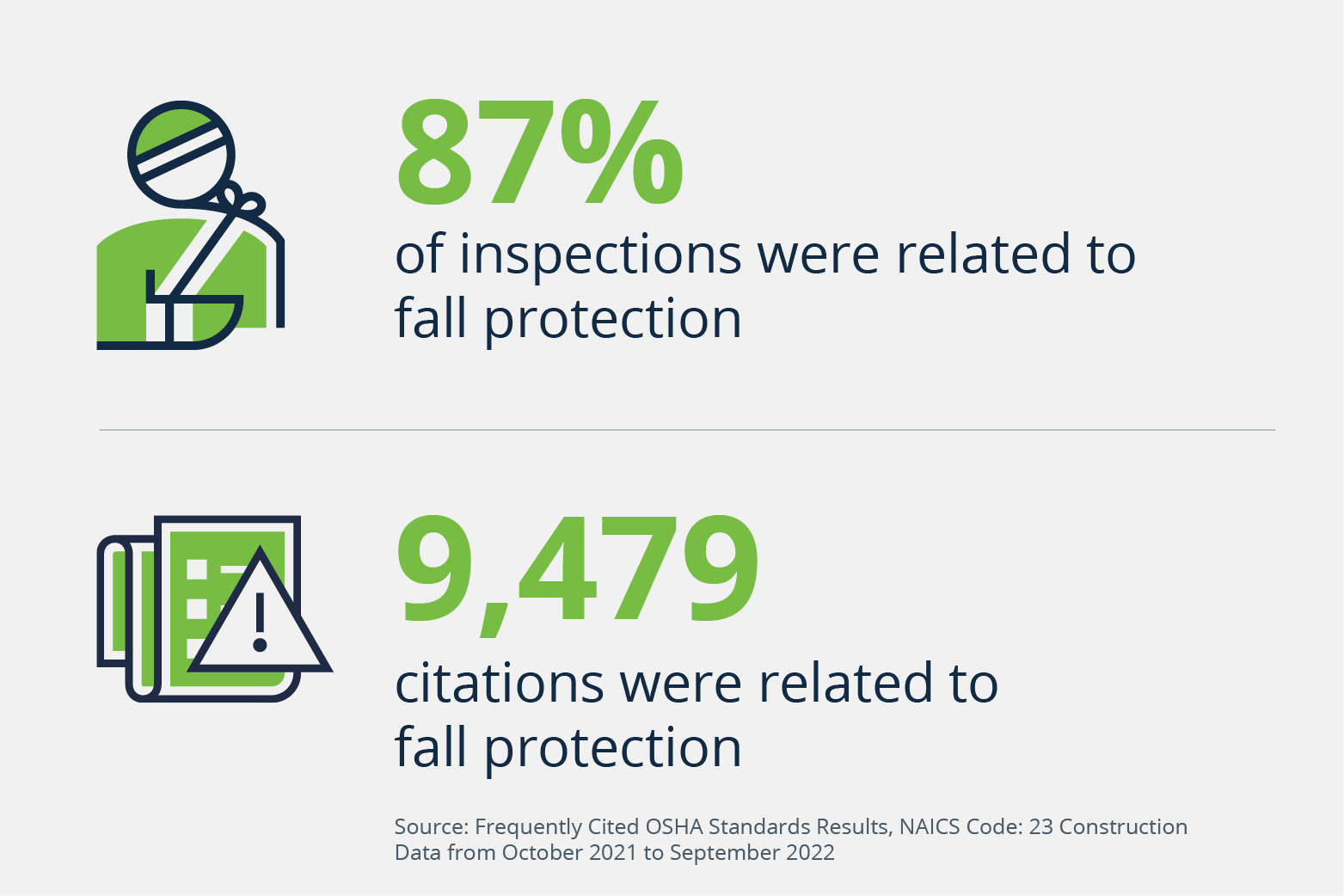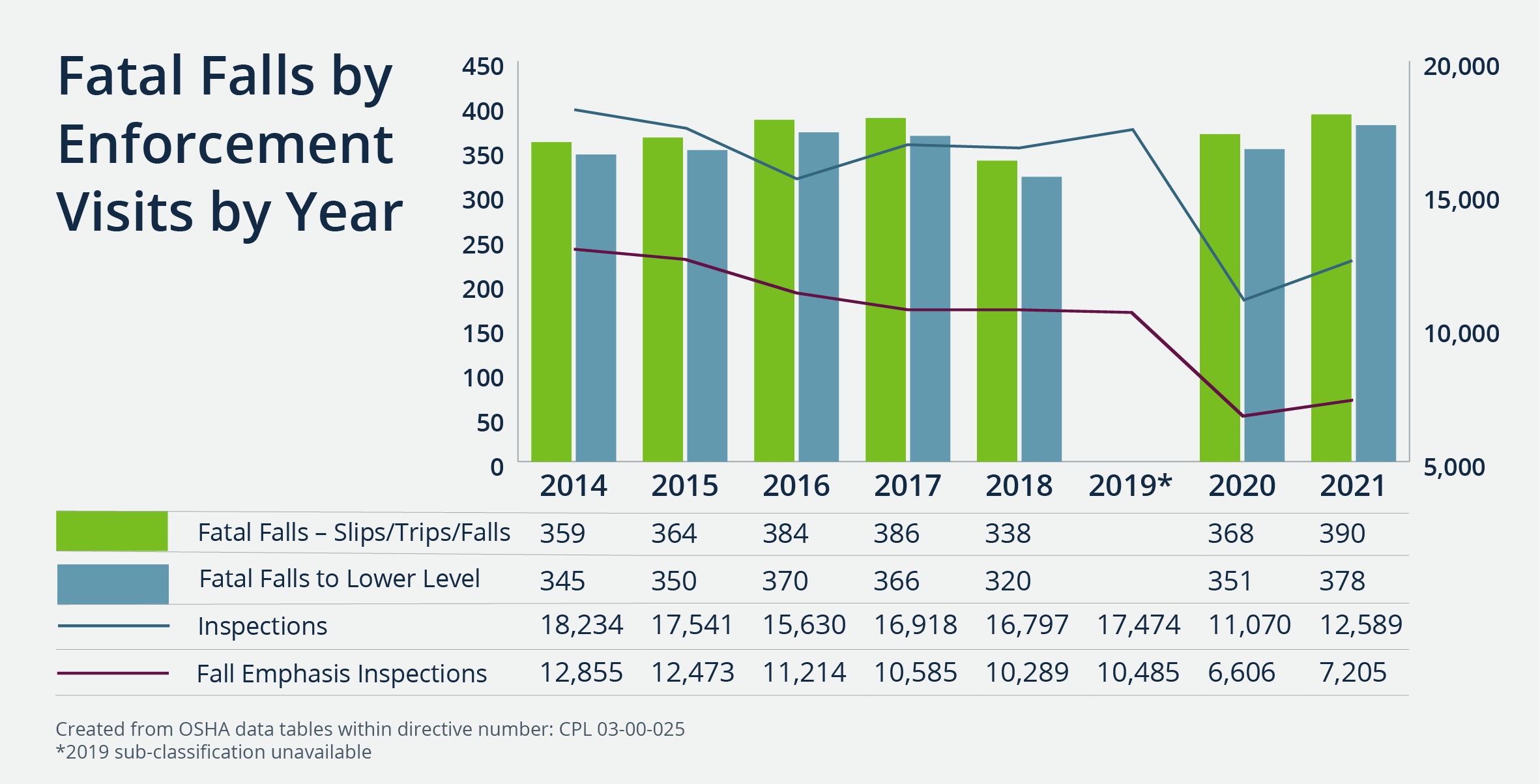Blog
OSHA's Fall Prevention National Emphasis Program: Expect More Site Visits
In 1994, the Occupational Safety and Health Administration (OSHA) issued Subpart M for construction, which required fall protection for workers exposed to falls on construction sites. Since then, there have been improvements in available fall prevention and arrest systems and a growing focus on preventing injuries and fatalities resulting from falls in both construction and general industry.

On May 1st, OSHA announced a new national emphasis program (NEP) to reduce and prevent workplace falls. This will likely result in more visits from OSHA inspectors, with a deeper focus on fall prevention for employers of any type that utilize or have a need for fall protection.
Falls Continue Despite OSHA Enforcement
OSHA has implemented numerous fall protection measures, including focused enforcement efforts, outreach efforts, national campaigns, annual stand-down days, special online tools such as construction V-tools, and the Construction Focus Four training program on fall prevention—with much of that focus on the construction industry. The top citation category for all construction (NAICS code 23) is listed as “duty to have fall protection,” followed by “ladders.” These two categories and a few others that deal with fall protection accounted for 8,805 of the 10,077 inspections conducted from October 2021 to September 2022. The citations issued from those fall protection and ladder visits totaled 9,479. Additionally, 9 of 10 OSHA regions have local emphasis programs specific to fall prevention, with the 10th region choosing to include falls in a construction regional emphasis program that covers other exposures as well.

Unfortunately, falls and falls from height continue to happen in both construction and general industry with no large decrease in count from 2014 to 2021, according to NEP Compliance Directive data. Data from that document indicates there may not be a strong correlation between the number of enforcement visits (whether general or focused fall protection visits) and the number of fall fatalities that occur each year. Statistics like these may be part of the reason for OSHA’s reinvigoration of prevention efforts around falls.

OSHA's Fall Prevention National Emphasis Program: Outreach and First Steps
OSHA’s stated purpose for rolling out this national emphasis program is to “identify and reduce hazards which are causing or are likely to cause serious injuries and fatalities from fall while working at heights.” While it remains to be seen whether this new approach will work or not, it is important for employers to know how the NEP may affect them and their employees.
For the first 90 days (essentially May–July) OSHA will be conducting outreach programs and gathering data on likely targets to visit. During the first 60 days, states with state OSHA programs will be evaluating whether to adopt the federal outline or institute an equally effective version of their own. After the first 90 days, site visits will begin.
OSHA encourages area offices to engage a variety of partners in outreach efforts and information sharing. Some of those listed in the NEP documents include:
- The media
- Unions
- Community groups
- Municipal licensing agencies
- Building material suppliers
- Machine and equipment rental outlets
- Industry associations
- OSHA partnership group members (such as Voluntary Protection Programs [VPP] and OSHA Alliance members)
- OSHA consultation offices
Which Industries Are Targeted?
Construction sites are an obvious and stated target for OSHA, but the program is also meant to be used within general industry. The NEP document lists 10 general industry targets. While some seem to indicate an industry segment, most are tasks that could be done in multiple industries:
- Rooftop mechanical work/maintenance
- Utility line work/maintenance (electrical, cable)
- Arborist/tree trimming
- Holiday light installation
- Road sign maintenance/billboards
- Power washing buildings (not connected to painting)
- Gutter cleaning
- Chimney cleaning
- Window cleaning
- Communication Towers
How OSHA Is Creating Its Target Visit List
Part of this NEP, as with others, is the process of generating a target visit list. OSHA is encouraging each local area to outline a geographical region and assign a duty officer to drive that area and list all workplaces and construction sites observed using or needing to use fall protection. OSHA will conduct visits based on the list generated. The NEP document also encourages area directors to populate that target list based on input from the media, unions, building departments, and other resources.
The NEP outlines several triggers for visits that can occur outside of the target list generated. Those triggers include:
- Plain sight observation by a duty officer. This can occur while driving by a jobsite, walking their dog around the neighborhood, or during enforcement visits related to other topics.
- Reports or complaints of incidents involving fall protection, or falls in general, may generate a visit where they may not have in the past.
- Referrals from any number of sources including other governmental agencies or members of the public. Part of the outreach programs suggested to the local OSHA offices involves partnerships with associations, unions, and other groups.
During a fall-related site visit, the duty officer will initially concentrate on fall exposures and controls. However, the plain sight doctrine is still in play. If the duty officer notes a trend on the logs, sees a hazard in plain sight, or is told about a hazard during an employee interview, they can expand their visit scope to include issues other than fall hazards.
The inverse is also true. If a duty officer is responding based on other issues such the current heat illness NEP and notes a fall protection issue, the visit will be expanded.
OSHA Standardizes Its Program
OSHA has had fall protection on its radar for years, and employers are accustomed to questions about and citations related to fall protection. This NEP is different in that it standardizes the approach taken across the country by all OSHA regions and increases the chances of getting a visit based on fall protection. Perhaps the most unusual part of this NEP is that it pulls in multiple outside organizations to influence employers from several angles.
In a recent press release, OSHA states that falls from elevations caused 13% of all workplace deaths in 2021. OSHA is expected to continue its efforts to prevent workplace falls and to continue to track these numbers to monitor the success of its efforts. If you have questions about this NEP or other safety-related topics, contact your Woodruff Sawyer account team.
Author
Table of Contents












